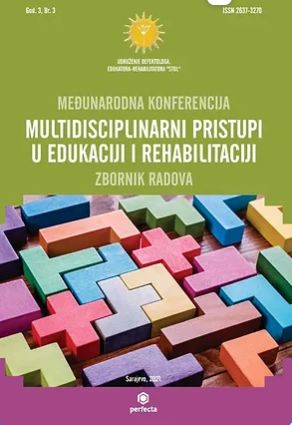KOGNITIVNA I EMOCIONALNA EMPATIJA KAO ČINIOCI STAVA UČENIKA TIPIČNE POPULACIJE PREMA VRŠNJACIMA SA SMETNJAMA U RAZVOJU
COGNITIVE AND EMOTIONAL EMPATHY AS FACTORS OF STUDENTS’ ATTITUDE TOWARDS PEERS WITH DEVELOPMENTAL DISORDERS
Author(s): Ana Lukić, Slađana Đorem, Jelena Milić, Bojan Joksimović, Milena Božinović, Vedrana JoksimovićSubject(s): Social Sciences, Education, Psychology, Inclusive Education / Inclusion
Published by: Udruženje defektologa, edukatora-rehabilitatora (STOL)
Keywords: emocionalna empatija; učenici; smetnje u razvoju.;
Summary/Abstract: Children with disabilities manifest developmental difficulties and do not reach a satisfactory level of development, especially if they are not provided with support in the form of care and education. Higher levels of empathy are a significant factor that can influence the emergence of more positive attitudes of students towards peers with disabilities. The aim of the research was to assess whether empathy has an impact on students‘ attitudes towards peers with disabilities. The study included 120 students of 4th and 5th grade of primary schools, both sexes, aged 10 and 11 years. The research was done in Banja Luka during 2020. Respondents were divided into two groups, those who attended classes with students with disabilities and those who did not. The Chedok McMaster scale was used to examine students‘ attitudes toward students with disabilities, while the Interpersonal Response Index was used to assess empathy. Correlation analysis revealed a significant (r=0.18; p<0.05) positive correlation between students‘ attitudes towards peers with disabilities and perspective. Students who attend classes with students with disabilities have significantly (t=-2.3; p=0.02) lower values of the total score of attitudes (3.05±0.28) compared to students who do not attend (3.16±0.28). Our research has shown that empathy has a significant impact on students‘ attitudes toward peers with disabilities and that students with a higher level of empathy have a more positive attitude toward these peers. Also, students who are included have a more negative attitude towards peers with developmental disabilities than students who are not included.
Journal: Multidisciplinarni Pristupi u Edukaciji i Rehabilitaciji
- Issue Year: 3/2021
- Issue No: 3
- Page Range: 283-297
- Page Count: 15
- Language: Bosnian, Croatian, Serbian

